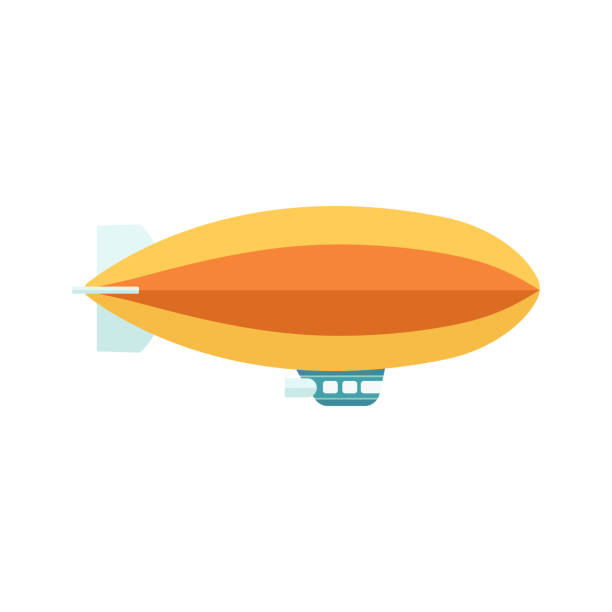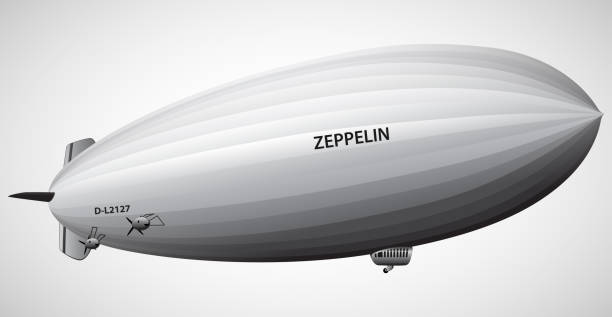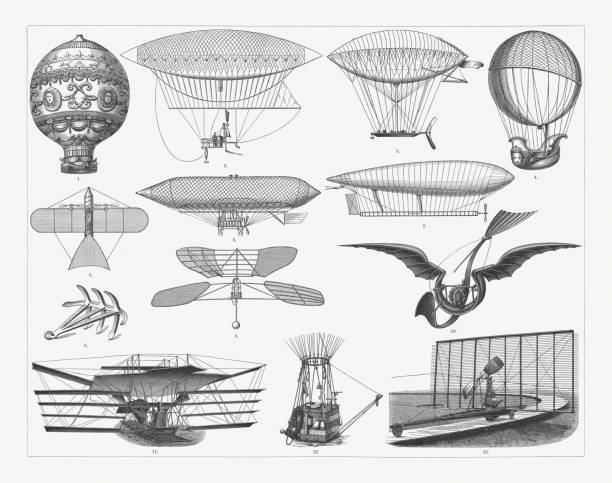
Vintage baloon with basket zeppelin aircraft in the flight. Retro air dirigible journey flat vector illustration isolated on white background.
Browse 100+ hydrogen blimp stock illustrations and vector graphics available royalty-free, or start a new search to explore more great stock images and vector art.

Vintage baloon with basket zeppelin aircraft in the flight. Retro air dirigible journey flat vector illustration isolated on white background.

Airship Blank White Flying Transportation Vector. Airship Inflatable Fly Transport, Aircraft For Travel. Hovering Blimp Air Ship For Passenger Journey Template Realistic 3d Illustration

Airship. Dirigible ink sketch on old paper background. Hand drawn vector illustration. Retro style stroke drawing.

Vintage airship Zeppelin. Dirigible balloon. Vector illustration

Airship. Ink sketch of dirigible isolated on white background. Hand drawn vector illustration. Retro style.

Historic flying machines: 1) Air ship "Deutschland", constructed by Friedrich Hermann Wölfert (German publisher and aviation pioneer, 1850 - 1897); 2 - 3) Biplane flying vehicle (1895), constructed by Otto Lilienthal (German aviation pioneer, 1848 - 1896); 4) Twelve-winged glider (1896), constructed by Octave Chanute (American civil engineer and aviation pioneer, 1832 - 1910); 5) Biplane hang glider (1896), constructed by Octave Chanute; 6) Observation kite balloon (1898), System Parseval-Sigsfeld (Germany); 7) Steam-powered Aërodrome No. 5, constructed by Samuel Pierpont Langley (American astrophysicists and aviation pioneer, 1834 - 1906). Wood engravings, published in 1898.

Digital restored 19th century engraving from the literary magazine Le Voleur Illustre 1889-90 Paris, France

Steel engraving of aerial Velocipede from inventor Delprad A velocipede is a human-powered vehicle with one or more wheels. Original edition from my own archives Source : " Gartenlaube " 1894

Airship travel in the past: 1) Montgolfier brothers' balloon (1783); 2) Giffard dirigible (1852); 3) Navigable balloon developed by Dupuy de Lome (1872); 4) Hydrogen-balloon by Charles and Robert brothers (1783); 5) Victor Tatin (1843-1913) compressed air powered Aeroplane (1879); 6) Airship by Paul Haenlein (1835-1905); 7) La France - Airchip by Charles Renard and Arthur Constantin Krebs (1884/85); 8) Anchor by Hervé; 9) Helicopter by Enrico Forlanini (1878); 10) Mechanical bird by Gustave Trouvé (1890); 11) Flying machine by Sir Hiram Stevens Maxim (1894); 12) Basket of the ballon "M.W." with equipment (M. W. is the name of a balloon of the German Association for the Promotion of Air Navigation, founded 1881.); 13) Flying machine by Horatio Frederick Phillips (1893). Wood engravings, published in 1897.

Alexandre Goupil’s design for a flying machine. The craft is a sesquiplane, meaning it has two sets of wings, one much smaller than the other. Goupil envisioned a steam engine inside the bulbous body, powering a single propeller at the front. Original edition from my own archives Source : Ilustracion Artistica 1885

Henri Dupuy de Lôme Navigable balloon first design date October 1870 from Magasin Pittoresque. Vintage etching circa mid 19th century.

Airship. Chalk sketch of dirigible on blackboard background. Hand drawn vector illustration. Retro style.

Fictional retro dirigible with basket passenger ladders and left wing on white background

High Resolution JPG,CS6 AI and Illustrator EPS 10 (with transparency effects) included. Each element is named,grouped and layered separately.

Fictional retro dirigible with basket passenger ladders and left wing on white background

The first balloon ascent of French inventor and aeronaut Jean-Pierre Blanchard (1753 - 1809), Paris, March 2, 1784. His balloon was the first with Hydrogen filling. Woodcut from the book "Das Buch der Erfindungen, Gewerbe und Industrien, 2. Band (The book of inventions, commerce and industries, Volume 2)", published by Otto Spamer, Berlin and Leipzig (1877)

Airship and hot air balloon vintage plates of vector air travel and aircraft design. Retro hot air balloons, airship, aerostat, dirigible or blimp with basket, gondola and propeller grunge tin plates

Steel engraving of engineer Otto Lilienthal after photography of Ottomar Anschütz in 1892 Lilienthal's training area was a hill formation called "Maihöhe" in Steglitz, near Berlin. Original edition from my own archives Source : " Gartenlaube " 1894

Air transport icons set, helicopter, airplane, hot air ballon, airship and rocket, vector eps10 illustration

Colored air transport icons set, vector eps10 illustration

Vector illustration. Parachute, hotair and rocket option banner

Seamless pattern with clouds and different colors cartoon aerostats flying in the sky. Flat design. Vector illustration.

vector illustration aircraft airship on nature background mountains

vector illustration aircraft airship on nature background mountains

vector illustration aircraft airship on nature background mountains

Orange blimp on a white background

vector illustration aircraft airship on nature background mountains

Children is wooden helicopter. Children is plane, toy. Hand drawn style

Airship, sticker for a children is room. Hand drawn style

vector illustration of a balloon flight over the beautiful mountainous terrain

High Resolution JPG,CS6 AI and Illustrator EPS 10 (with transparency effects) included. Each element is named,grouped and layered separately.

vector illustration of a balloon flight over the beautiful mountainous terrain

Man trying controls airship vector illustration. Dirigible flying in sky. Retro zeppelin flight flat style concept. Aeronautics technology idea

Passenger airship on white background is insulated

Map markers with air transport icons, vector eps10 illustration

Zeppelin icon vector image. Can be used for Transport.

Vector illustration of blimp

Control Tower icon vector image. Can be used for Aviation.

white airship against the blue sky

Cartoon Illustration Dirigible Isolated on White Background. Vector.

Different colorful air balloons seamless pattern. Stock flat vector illustration.

Submarine icon vector image. Can be used for Transport.

Colorful spaceship on a white background

Airship with shadow simple icon, vector eps10 illustration
© 2025 iStockphoto LP. The iStock design is a trademark of iStockphoto LP. Browse millions of high-quality stock photos, illustrations, and videos.
Do Not Sell or Share